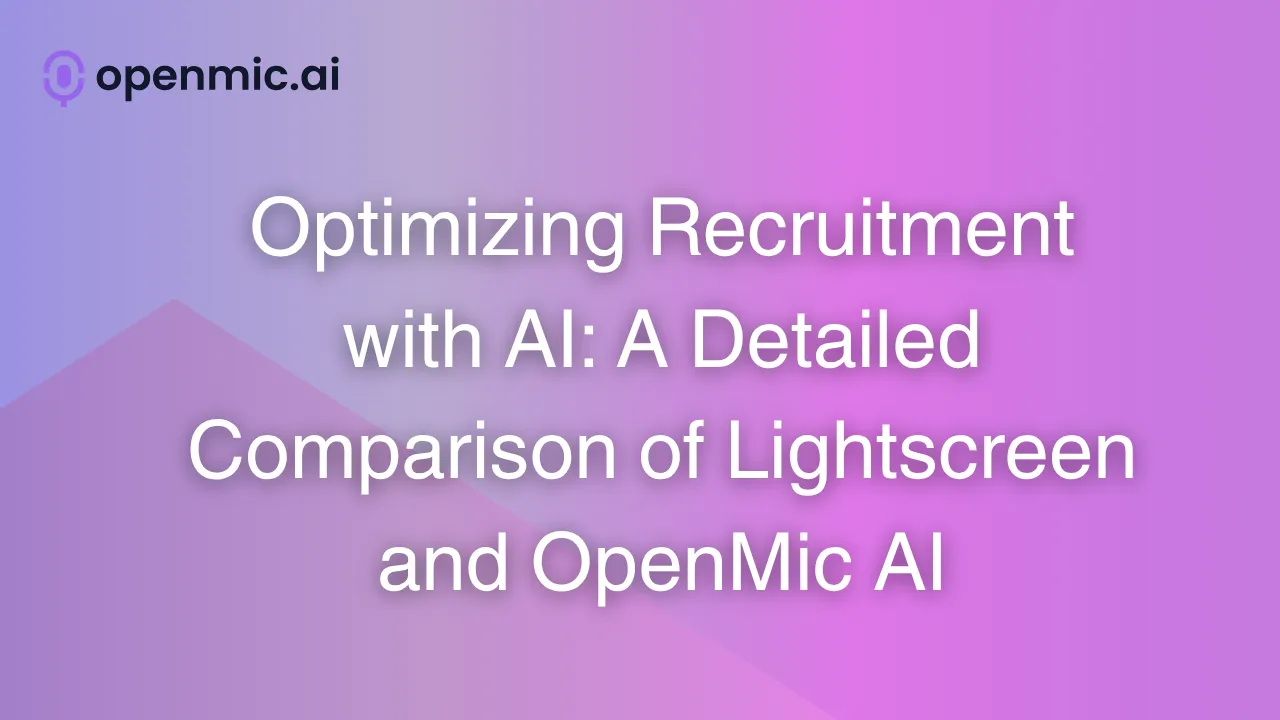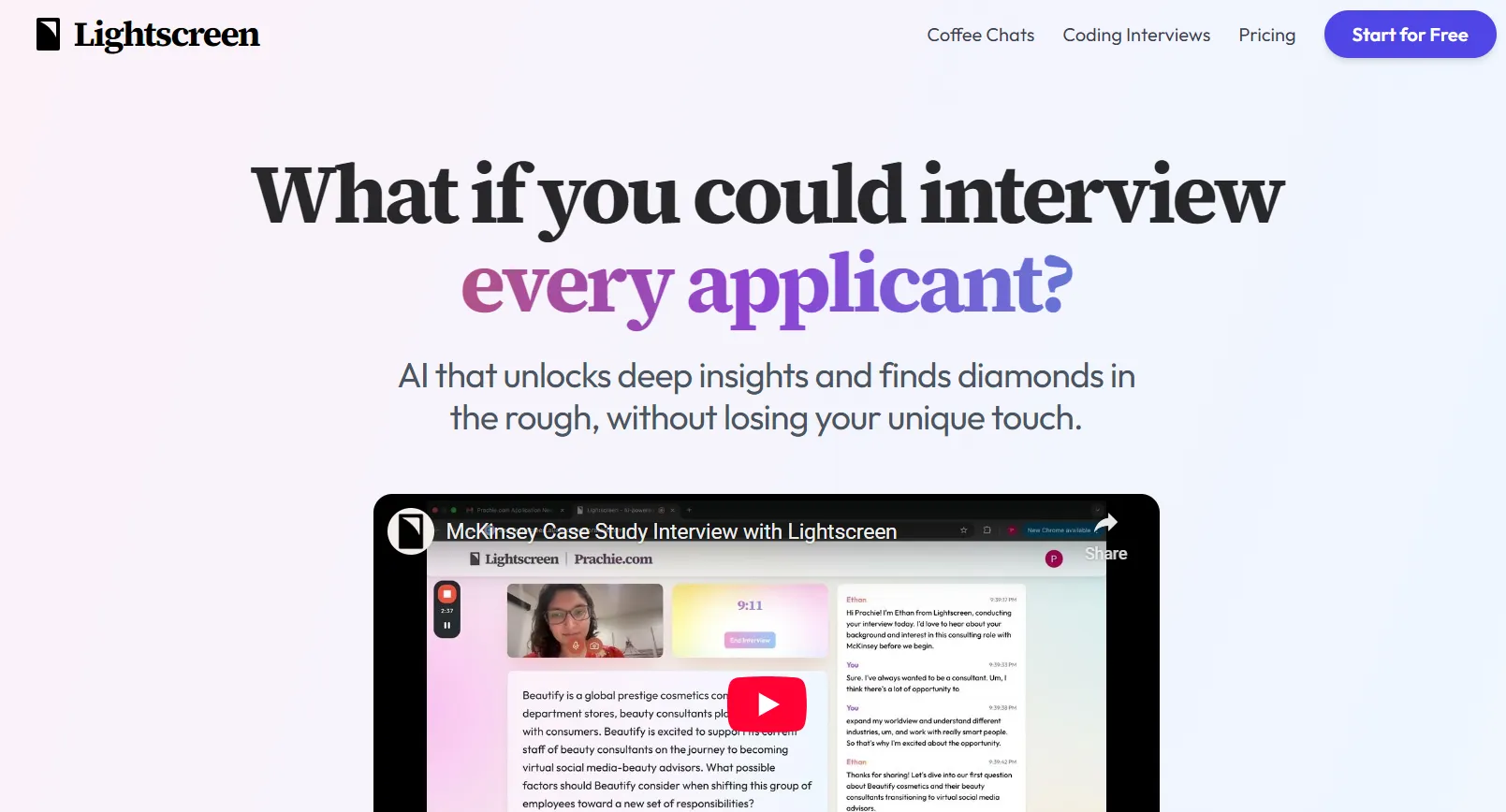
Optimizing Recruitment with AI: A Detailed Comparison of Lightscreen and OpenMic AI
In today’s competitive hiring landscape, AI-driven recruitment solutions are transforming how businesses assess and hire talent. Both are two advanced platforms for optimizing recruitment process by offering AI-powered interview automation, but their features and applications vary greatly. While Lightscreen is focused on technical role assessments, OpenMic AI offers a more versatile, voice-based solution suitable for a wide range of job roles across industries. This article explores both platforms' features, compares their strengths, and provides an analysis of which platform may be best suited for your business needs.
Lightscreen: A Cutting-Edge AI for Technical Assessments
It is an AI-driven platform designed to enhance the recruitment process by automating interviews, particularly for technical roles. By leveraging AI technology, It aims to improve the hiring process through a more structured and efficient interview format.

AI Interviewer – Ethan
One of It’s key features is its AI-powered interviewer, Ethan. Ethan acts as the primary interviewer, evaluating candidates for coding challenges, case studies, and technical assessments. Ethan’s approach focuses on assessing a candidate’s problem-solving abilities, technical skills, and ability to communicate complex ideas clearly.
Advanced Cheating Detection
In today’s competitive world, cheating is becoming a significant concern during recruitment. It addresses this issue by implementing sophisticated AI-based cheating detection. Instead of relying solely on plagiarism checks, the platform analyzes behavioral patterns that may indicate dishonest practices, ensuring only the most qualified candidates are selected.
Customizable Assessments
This platform also allows businesses to customize their interview formats. This feature enables companies to create specific assessments that align with their needs, whether for highly technical roles or more generalized case study evaluations. Customization is particularly useful for organizations with specialized hiring needs in deep tech or engineering fields.
OpenMic AI: Voice and NLP-Powered Interview Automation
In contrast to Lightscreen’s technical interview focus, OpenMic AI takes a more versatile approach to recruitment by integrating voice automation and natural language processing (NLP) into the hiring process. The platform is designed to cater to a wider variety of job roles, providing businesses with an adaptable and scalable AI interview solution.
Voice-Based Interviewing and NLP
Its primary strength lies in its ability to conduct voice-powered interviews. Utilizing NLP technology, the platform evaluates candidates based on their spoken responses, making the interview feel more natural and engaging. This capability allows businesses to assess candidates’ communication skills, problem-solving approach, and critical thinking in real-time conversations.
Customization and Flexibility
It offers a highly customizable solution that can be tailored to any job role. Whether a company needs to evaluate soft skills, technical knowledge, or customer service abilities, It can adjust to meet those specific needs. Its customizable voice assistants can be adapted to align with an organization’s hiring style, providing a more personalized experience for candidates.
Multilingual Capabilities
It also supports multilingual interviews, making it an ideal solution for companies with global hiring needs. By offering interviews in various languages,It ensures that companies can assess candidates from different cultural backgrounds, enhancing diversity in recruitment.
Feature Comparison: Lightscreen vs. OpenMic AI
While both platforms offer AI-driven interview solutions, they cater to different needs, and their functionalities diverge significantly. Let’s break down how Lightscreen and OpenMic AI stack up against each other:
1. Specialization vs. Versatility
- Lightscreen: Specializes in technical assessments, particularly for roles requiring deep technical expertise in fields like coding, business analysis, and deep tech assessments. It is ideal for businesses focused on evaluating highly specialized talent.
- OpenMic AI: Offers versatility by supporting a wide range of industries and job roles. Whether it’s technical interviews, soft skills evaluation, or customer-facing roles, OpenMic AI adapts to multiple job functions, making it suitable for a broader set of recruitment needs.
2. Cheating Detection
- Lightscreen: Boasts advanced AI-driven cheating detection, analyzing behavioral patterns and subtle inconsistencies to identify potential cheating, especially in coding assessments and technical evaluations.
- OpenMic AI: While It also incorporates cheating detection, it primarily focuses on verbal responses during interviews. Its cheating detection algorithm looks at inconsistencies in speech patterns and behavioral cues, making it suitable for both technical and non-technical roles.
3. Candidate Experience
- Lightscreen: Designed with technical candidates in mind, It offers an efficient and low-stress environment for evaluating coding skills and problem-solving abilities. However, it might feel somewhat rigid for candidates applying for non-technical roles.
- OpenMic AI: Provides a conversational, human-like interview experience, which is especially appreciated by candidates across all industries. It’s focus on voice interactions creates a more engaging and relaxed environment, which helps candidates feel at ease during the interview process.
4. Customization
- Lightscreen: Customization is possible, but it is somewhat limited to technical interview formats. Businesses that primarily hire for technical roles or deep tech positions will benefit most from it’s customizable assessments.
- OpenMic AI: Offers extensive customization, from creating personalized voice interactions to modifying the flow and tone of interviews. This high degree of flexibility makes it an ideal solution for businesses hiring for a diverse range of roles across different industries.
5. Global Reach
- Lightscreen: While it offers a high level of technical specificity, Lightscreen is more focused on English-speaking markets and technical positions.
- OpenMic AI: With its multilingual capabilities, OpenMic AI has a global reach, making it a more suitable option for companies hiring candidates from diverse linguistic and cultural backgrounds.
Competitors in the AI-Powered Recruitment Space
Both Lightscreen and OpenMic AI operate in a growing market of AI-driven recruitment platforms. While these platforms excel in their unique areas, several competitors also offer similar features:
- HireVue: A prominent player in AI-powered video interviewing, HireVue competes with both Lightscreen and OpenMic AI by combining AI analysis with video assessments. However, it lacks the conversational aspect that OpenMic AI offers.
- Codility: Focuses on coding assessments, similar to Lightscreen, but without the broader voice automation or NLP capabilities that OpenMic AI brings to the table.
- XOR.ai: A competitor to OpenMic AI, XOR.ai offers AI-powered chatbots for recruitment, focusing on automation and conversational interviews.
- Spark Hire: Known for its video interview platform, Spark Hire offers a more basic interview tool that does not provide the depth of AI-driven analysis that Lightscreen and OpenMic AI deliver.
Conclusion: Why OpenMic AI is the Superior Choice
While Lightscreen is an excellent tool for technical assessments, particularly for coding challenges and deep tech roles, OpenMic AI provides a more versatile, cost-effective, and scalable solution that caters to a broader range of job functions. Its voice automation and natural language processing (NLP) technology set it apart, providing a conversational and human-like interview experience that resonates well with candidates across various industries.
With multilingual support, customizable voice assistants, and the ability to handle both technical and non-technical roles, OpenMic AI offers a comprehensive AI solution for businesses looking to scale their recruitment efforts. Whether you’re hiring for a technical role or assessing soft skills, OpenMic AI’s flexibility and accessibility make it the better fit for companies seeking an adaptable, future-proof hiring solution.
For businesses looking to improve the recruitment process and ensure a seamless candidate experience, OpenMic AI provides the better value and greater scalability compared to Lightscreen.
Book a free demo of OpenMic AI NOW!
More curious about OpenMic AI, these blogs may help you:
- A Comparative Look at Sandra AI and OpenMic AI: Features, Costs, and Suitability for Dealerships
- Trace AI or OpenMic AI: A Detailed Comparison of AI Solutions for Customer Service and RCM in Healthcare and Financial Services
- Toothy or OpenMic AI: The Best AI-Powered Solutions for Dental and Medical RCM
Explore related blogs
.png)
Voice AI for Mass Tort Lawyers: How Conversational AI Is Revolutionizing Case Intake & Client Engagement
.png)
Top 5 AI Answering Services for Law Firms in 2025 (24/7 Reception & Intake)
.png)
Top 5 White-Label Voice AI Platforms in 2025 (Best for Agencies & SaaS Providers)
Let AI Handle Your Phones So You Can Focus on Growth
Start your free trial and see how OpenMic’s AI voice agents can streamline calls, boost conversions, and deliver fast, 24/7 customer service — without hiring more staff.






.svg)